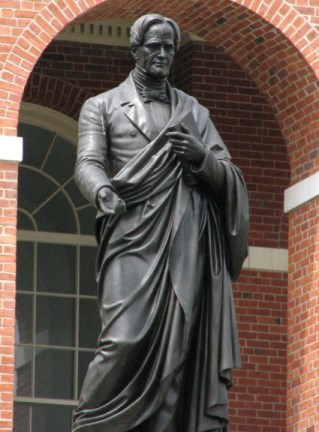Background: Stebbins was one of 9 children born in New York City to a wealthy family. Her father was a bank president. Her mother was from Nova Scotia. Emily's family encouraged her pursuit of art from an early age.
Training: Emma studied at several American studios, and was elected to the National Academy of design in 1843, when she was 28.
Private Life: Emma was 42 when she moved to Rome in 1857. There, Emma was able to become involved in the bohemian and feminist lesbian lifestyle, which was far less acceptable in New York. She stayed in Rome for over a decade.
Emma moved in with Harriet Hosmer, who lived with Charlotte Cushman, a retired American actress who was a kind of a guardian and patron to many artists. Charlotte, who was the same age as Emma, was confident, strong, and charismatic. Emma and Charlotte developed a relationship and soon began traveling together. In Rome, Charlotte hosted a salon frequented by Emma and Harriet and other sculptors that helped to promote Emma's career, just as she had helped Harriet when she first arrived. Charlotte helped Emma receive some of her more important public commissions.
 |
| Bust of Charolotte Cushman by Emma Stebbins Internet |
In 1870, Emma and Charlotte moved back to the United States; they set up households in Newport and Boston. Charlotte's health was still compromised, and Emma was starting to feel the effects of marble dust from many years of doing her own carving.
In 1871, Charlotte resumed her stage career. She no longer had the stamina for performing in plays, but she developed a remarkable ability as a dramatic reader, reciting scenes from Shakespeare, ballad poetry, dialect poems and humorous pieces. The public loved her in this new role.
In 1876, when Emma was 61, Charlotte died of pneumonia at the age of 59. Following her death, Emma never produced another sculpture. She spent her final years producing a book of Charlotte Cushman's correspondence, which came out in 1878.
Stebbins died in New York in 1882, at the age of 67.
Career: In her 20s and 30s, Emma was a sort of amateur artist, working in oils and watercolors, in her upper middle-class home in New York City. She made likenesses of her friends and copied the masters. She continued taking classes. Occasionally one of her works was shown at an exhibit in New York.
When Emma was 42, in 1857, Emma's brother, who was the head of the New York Stock Exchange, sponsored her move to Rome. Rome offered a large infrastructure which supported art: teachers, technicians, artists, students and a continuous flow of international collectors. Emma devoted herself to sculpture and studied anatomy and modeling with American Paul Akers.
In the 1860s Emma produced a dozen marble sculptures and two important public works in bronze. The bulk of her work was portrait commissions. She did her own carving, instead of hiring stonemasons. In 1865, her bronze statue of educator Horace Mann was erected at the Massachusetts State House.
 |
| Educator Horace Mann, 1865 |
 |
| Angel of the Waters, 1873 Bethesda Terrace, Central Park, New York City |
Stebbins' best-known work is Angel of the Waters (also known as Bethesda Fountain) at Bethesda Terrace in Central Park, New York City. Angel of the Waters is a bronze figure with outstretched wings; her arms reach downward, blessing the water below. Her pedestal is supported by four cherubs, representing Health, Temperance, Purity, and Peace. Bethesda Terrace complex is widely considered one of the great works of nineteenth-century American sculpture. It was unveiled in 1873.
Examples:
 |
| Machinist and Machinist's Apprentice, c. 1859 Chicago / Jan's photo, 1859 |
 |
| Rear view of Machinist and Machinist's Apprentice, c. 1859 |
 |
| Commerce, 1860 Hecksher / Jan's photo, 2012 |
 |
| Industry, 1860 Hecksher / Jan's photo, 2012 |
 |
| Christopher Columbus, 1867 Columbus Park, Brooklyn, NYC |
